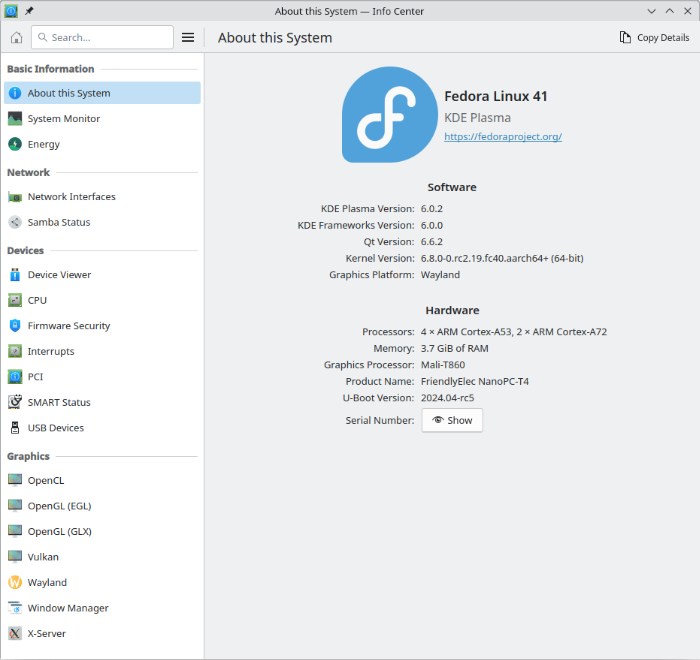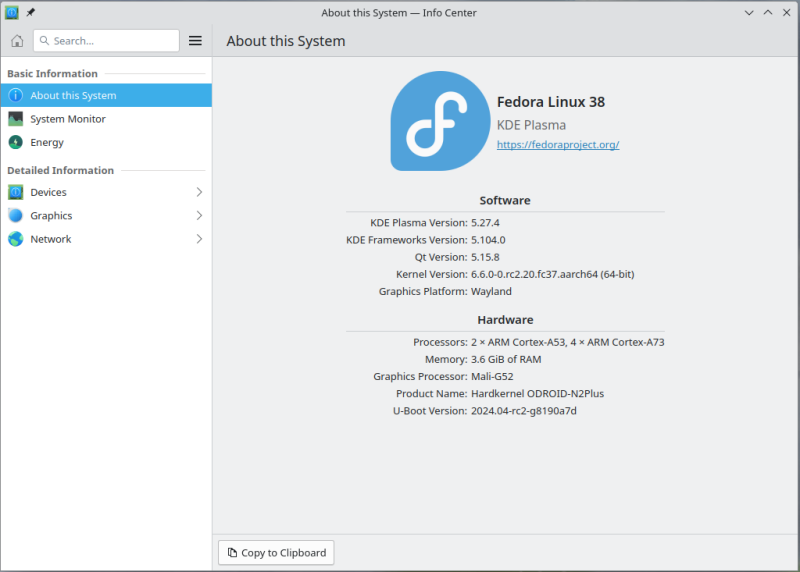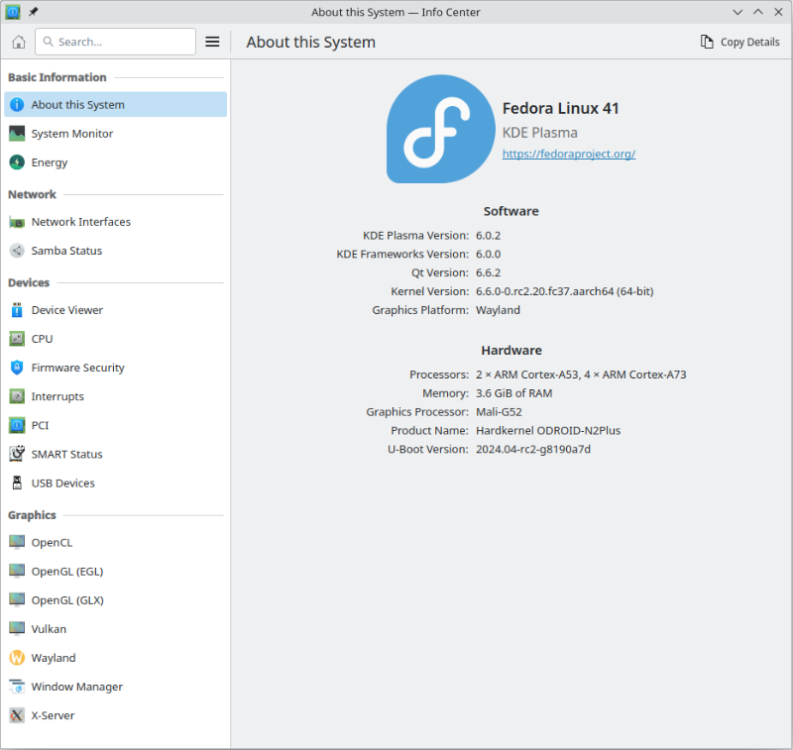
usual user
Members-
Posts
510 -
Joined
-
Last visited
Content Type
Forums
Store
Crowdfunding
Applications
Events
Raffles
Community Map
Everything posted by usual user
-

how to debug/fix armbian-config for kernel-update?
usual user replied to hi-ko's topic in Software, Applications, Userspace
Looks like some partition format mixup, btrfs vs. ext4. -

how to debug/fix armbian-config for kernel-update?
usual user replied to hi-ko's topic in Software, Applications, Userspace
You are still using legacy firmware, the first step should be to switch to mainline. -
Setup mem=16G at kernel cmdline.
-
The issue is probably due to the fact that rk35xx SoCs have to carve out some memory areas above 16 GB as reserved. Access to those areas leads to crashes. Because no fully open source TF-A is available yet, current mainline U-Boot has mechanisms landed to take the area information from the closed source TPL. Chances are the firmware you're using hasn't backported this yet, because devices larger than 16GB are only now becoming widely available in the open market.
-
I would run: gpiomon --consumer 433MHz --edges both --format "%S %E" con1-07 | tee 433MHz.log I would let gnuplot chew on the result of the gpiomon run to visualize (433MHz.pdf) it, because I can interpret an image better than any columns of numbers. This is a program that is over thirty years old and works on almost every platform and can be used in any environment, and you can only complain that it is not a special solution and that you don't have to rebuild half the system yourself, but that doesn't bother me. After I have identified the relevant places, I would take the corresponding timeings from the log and thus generate a suitable gpioset command that imitates the original.
-

Can we make RK3399 GPU work on Linux Kernel 6.X
usual user replied to Hand Rawing's topic in Rockchip
No, it's just the spec with which my currently running mesa is built. Already the mesa version with which I started had all the necessary, essential functions. Of course, all bug fixes and improvements that have been incorporated in the meantime are not included there. No, there is not much to see in terms of kernel. As long as the Panfrost driver is built and the Mali GPU is properly wired-up in DT, there is nothing to do. It's about the user space counterpart mesa. It is the component that make use of the GPU the kernel exposes. If you want to check all dependencies, you have to look at all spec files that are pulled by Requires from the mesa package. For me, however, this is done by the package manager during installation. And to build mesa, I install all BuildRequires with: dnf builddep mesa.spec But building Mesa yourself has long since ceased to be necessary, as no modifications are necessary and the standard package works out-of-the-box. Your build configuration options are looking incomplete. Here's an excerpt from the build.log resulting from the spec file: /usr/bin/meson setup --buildtype=plain --prefix=/usr --libdir=/usr/lib64 --libexecdir=/usr/libexec --bindir=/usr/bin --sbindir=/usr/sbin --includedir=/usr/include --datadir=/usr/share --mandir=/usr/share/man --infodir=/usr/share/info --localedir=/usr/share/locale --sysconfdir=/etc --localstatedir=/var --sharedstatedir=/var/lib --wrap-mode=nodownload --auto-features=enabled . redhat-linux-build -Dplatforms=x11,wayland -Ddri3=enabled -Dosmesa=true -Dgallium drivers=swrast,virgl,nouveau,r300,svga,radeonsi,r600,freedreno,etnaviv,tegra,vc4,v3d,kmsro,lima,panfrost,zink -Dgallium-vdpau=enabled -Dgallium-omx=bellagio -Dgallium-va=enabled -Dgallium-xa=enabled -Dgallium-nine=true -Dteflon=true -Dgallium-opencl=icd -Dgallium-rusticl=true -Dvulkan-drivers=swrast,amd,broadcom,freedreno,panfrost,imagination-experimental,nouveau -Dvulkan-layers=device-select -Dshared-glapi=enabled -Dgles1=enabled -Dgles2=enabled -Dopengl=true -Dgbm=enabled -Dglx=dri -Degl=enabled -Dglvnd=enabled -Dintel-rt=disabled -Dmicrosoft-clc=disabled -Dllvm=enabled -Dshared-llvm=enabled -Dvalgrind=enabled -Dbuild-tests=false -Dselinux=true -Dandroid-libbacktrace=disabled -

Can we make RK3399 GPU work on Linux Kernel 6.X
usual user replied to Hand Rawing's topic in Rockchip
Have you made sure that all BuildRequires have been properly fulfilled and that the build configuration options have been selected correctly? Especially hardware-related ones. -

Can we make RK3399 GPU work on Linux Kernel 6.X
usual user replied to Hand Rawing's topic in Rockchip
I've started with this, but the logs provided are created with this system: However, the system used is not really important, the Mali support has been very mature in mainline for a long time, so any correspondingly built system should be usable. -

Can we make RK3399 GPU work on Linux Kernel 6.X
usual user replied to Hand Rawing's topic in Rockchip
Works for me since ages. glmark2-wayland-nanopc-t4.logclinfo-fp-nanopc-t4.log -

Odroid N2 with Armbian Bookworm; emmc boot fail
usual user replied to hjheins's topic in Odroid N2/N2+
I guess with such an attitude you certainly can't motivate anyone to find an immediate solution to your problem. Maybe you'll be lucky and it will work with a future release, but until then all you can do is keep trying and waiting. You got what you paid for. The currency here is to contribute to the project (Armbian) and help with problem analysis. The project is community driven and you are a member of the community. -

Odroid N2 with Armbian Bookworm; emmc boot fail
usual user replied to hjheins's topic in Odroid N2/N2+
Does it make a difference if you drop in this firmware? -

RK3399: H.264 decoding not exposed in v4l2, only MPEG2 and VP8
usual user replied to McTurbo's topic in Orange Pi 4 LTS
Since userspace cannot sensibly select between two decoder instances of the same type, the H.264 hanto decoder is usually disabled for the rk3399 and the H.264 rkvdec is preferred. videoX-infos-nanopc-t4.log -
meson-g12b-odroid-n2-plus.dtb is a base DTB with a static applied overlay. In your mentioned thread at post 23 is a reference to a parallel thread where the overlay source is provided. So prepare a PR so that the overlay can be included in Armbian. You'll probably reap tons of grateful users who have been waiting for someone to make the effort.
-
Some settings that were set at build time can't be modified at runtime. This requires a new firmware build, e.g. to set the boot delay to 0, the build configuration has to be set to "CONFIG_BOOTDELAY=0". This is due to the build configuration. The build configuration determines the properties of a binary created from a certain source. These can be detail settings, or even decisive for which hardware it is usable. Finally, U-Boot can be built for all devices from the same source of a given release version. E.g. "make libretech-cc_defconfig" prepares a default configuration for LePotato. You can use "make menuconfig" to fine tune it afterwards. I don't know the details of Armbian's build framework, but I'm sure you can inject a patch that implements your desired change.
-
This is not correct. Due to its size, U-Boot must be run from RAM. The RAM must therefore already be initialized before U-Boot can be loaded at all. This is usually done by Trusted Firmware-A (TF-A). U-Boot is only the payload (in TF-A terminology: BL33). You might want to read TF-A's documentation to understand the boot flow, I think here is a good place to start. You're lucky if TF-A is open source for your SoC, but often only a binary BLOOB for BL2 and BL31 is provided by the SoC manufacturers.
-
Your firmware is build without persistent Environment. Only the compiled-in Environment is used, which can only be modified before build.
-

Upgrade to bookworm failed - system does not start?
usual user replied to bananapinas's topic in Amlogic meson
I'm glad you were able to solve your issue. However, I will still stick with my firmware in SPI flash, because it gives me slightly more control over the boot process: -

Upgrade to bookworm failed - system does not start?
usual user replied to bananapinas's topic in Amlogic meson
Since you're still using a nine-year-old firmware that was built almost three years ago, I'm assuming that you haven't transferred the firmware that came with the linux-u-boot-odroidn2-current package to the firmware area. As far as I know, this is a process to be initiated manually in Armbian. The firmware used obviously can't handle the bootflow of the more advanced OS or maybe some old bootflow artifacts weren't cleaned up properly. -
Since you have access to all the necessary components, grab an ODROID-M1 OS image of your choice, copy the components into it, and test. If you install the OS image in the eMMC, be prepared to reinstall the original firmware. The ODROID-M1S does not have SPI flash and expects the firmware in the first instance in the eMMC. This means that the original firmware will be overwritten. Alternatively, you can test with a microSD card, but you have to shortcircuit the MASK ROM pads each time at boot so that the firmware is loaded from there. If you only transfer the firmware into the eMMC, you can also start the OS image of micrSD without MASK ROM intervention, this simplifies testing, because in the OS image only the DTB has to be added and the OS image can be transferred to a microSD card more easily. Nothing has to be build in the first step by yourself, try testing the already availabe components.
-
Just to demonstrate what such a concern would mean for the distribution of my choice: The only thing in OS space that is really device-specific is the devicetree, which describes how the device is wired. For the linux kernel, it is only relevant that the corresponding drivers for the components listed in the devicetree are also built using the necessary options. Since the drivers for the rk3568 SoC are the same as for the rk3566 SoC (they are wired differently only through the devicetree), there is no need for any special action in this case. So all I'm missing is a mainline binding compliant devicetree, and I'm done. Now all that's missing is a firmware that can start the OS of choice. And this contains device-specific code that can't be copied from another device, and must be built specifically for this device. Fortunately, everything necessary has already been posted on the U-Boot mailing list. The devicetree used still has shortcomings, but it is a start. In order to verify the handling of different binary bloobs with my build system, I already build the firmware regularly. It's also included in my provided firmware uploads, but I haven't communicated it as I don't own an ODROID-M1S and therefore can't verify its functionality. For me, the conlusion means: - Install the firmware dd bs=512 seek=64 conv=notrunc,fsync if=odroid-m1s-rk3566/u-boot-rockchip.bin of=/dev/${entire-device-to-be-used} - run the ODROID-M1S in UMS mode and tranfer my current image to a NVME - Since there is no proper mainline devietree, I would use the one that falls off during the firmware build and copy it in cp /somewhere/rk3566-odroid-m1s.dtb /usr/lib/modules/linux/dtb/rockchip/rk3566-odroid-m1s.dtb And I'm ready to rumble. The same should be able to work with an Armbian ODROID-M1 image.
-
If there is already firmware with U-Boot as a payload on the device, the UMS functionality is a possibility. In the meantime, all my firmware builds have easy access to this functionality, as long as the support requirements are met. I don't know the support status of the Allwinner H616 SoC, hence YMMV.
-
Normally, I would have said: "With suitable firmware in SPI flash, a raw image on any storage device is sufficient". This is still true for FC38, but further development of the kernel has revealed a flaw in the support of the S922X SoC. This results in a kernel exception for operation with an ODROID N2/N2+. Of course, this means that it no longer works out-of-the-box for newer releases. As far as I know, no one has yet provided a mainline acceptable solution, it is just a revert of the advancement. Of course, this is not a long-term solution and is not accepted in mainline. Rusticl doesn't seem to be able to use the Mali GPU in your setup. I can't tell if the kernel doesn't make it available via the panfrost driver or if Mesa 22.3.6 doesn't even provide rusticl panfrost driver support yet. For a quick test, I started FC38 again: As you can see from the clinfo-02.log, Mesa 23.1.9 still lacks basic extensions for rusticl. So it's quite possible that mesa 22.3.6 isn't enough. But it may also be that it is messed up by your additionally installed CL platforms.
-
I'm currently running this: since Debian based systems are for my taste way to stable - outdated. At times, I grab a nightly image, rearrange it to my liking, drop in my personal configuration preferences and use it till the cycle restarts. Nothing special, the key is current mainline releases. Panfrost has been very mature for a long time, so the kernel version may be a bit older. But of course, the latest version comes with the latest fixes and improvements. The same goes for Mesa, and that's where the current release is important, as the development of Rusticl is still quite vivid. To use a version that is more than a year old, and thus to forego any improvements that have taken place during this time, is quite courageous. But nevertheless, I would be interested in the output result of this command: RUSTICL_ENABLE=panfrost clinfo
-

Odroid N2 with Armbian Bookworm; emmc boot fail
usual user replied to hjheins's topic in Odroid N2/N2+
The device firmware is the only truly device-specific code that initializes the SoC and loads the OS. In the x86 architecture world, this is called BIOS. It often uses U-Boot as payload, but there are other ones as well. With its proprietary implementation, Petitboot can't even use the most common standard bootflows and will be therefore usually replaced by mainline firmware versions. Mainline firmware for ODROID-N2/N2+ -
I haven't tried any of that. I only used the distribution of my choice. It is in no way designed specifically for a specific device. The only requirement to use it is a firmware that is capable of booting the system. But since there's mainline firmware support for many devices, and I've learned to build it from the sources according to my needs, the same OS image works the same way for me for every device. To create the previously attached log file, I only had to use an environment variable to reveal the backend to be used with rusticl and was ready to go. The user space doesn't use anything device-specific, but is only built from current mainline releases. That's what the OS developers did for me, and they don't even know what devices I'm using it on.



